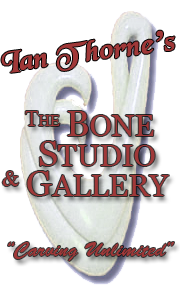
The Bone Studio and Gallery ... 
Materials
I use a wide range of materials for my carving. Most carving in New Zealand is made of beef bone which is generally quite white and clean grained -- much like a cheap version of ivory but limited in size by how much the farmer feeds his cows. The finish that can be achieved is high and it holds good detail. Beef bone is what students are trained on as it is readily available and has little grain to combat.

Sally's working on |
|---|
Whalebone is the easiest traditional material to carve (as compared to jade which requires diamond drills) and I am lucky enough to have come across some of it while beachcombing. Other pieces were given me by others who have found them washed up around our coast. Whalebone can have many characteristics and comes from jawbones, teeth, ribs and shoulders of medium to large whales stranded on shallow beaches over the years. Some I have are around 100 years old.
I also carve with recycled ebony that I get from broken carvings of elephants and statues found in antique and junk shops around New Zealand. Ebony carves in a similar fashion to bone but is black or very dark brown and looks awesome when well carved and polished.
Shells such as paua and mother-of-pearl are carved when available and are also used as inlays in other work. They can add beautiful features and colour to accentuate a piece and bring it out of the ordinary.
Cow horns, goat horns, deer antler and recycled water buffalo horn can also be added as inlays or carved in their own right and make beautiful earrings and pendants.
Over the last 10 years with inspiration from people like Chris Charteris and Steve Molloy I have trained in soft and hard stone carving.The soft stones are easy to work but often undervalued as people think 'soft' means easy!! Not so, but hard stone work is much more difficult and requires a large range of expensive diamond coated/impregnated cutting and grinding discs, polishing pads and angle grinders to work efficiently. It can take weeks to make one piece but the results are stunning and permanent. Mostly I make smallish pieces for galleries and homes, but do much larger pieces at symposia throughout Aotearoa when we often have up to 2 weeks to complete the work followed by an auction. Working on this scale and with these materials gives me variations in style and size which helps keep up my interest and enthusiasm. While I love working whalebone and teeth, these other materials help keep my options open.
Like most New Zealand carvers, I have a great love of whales and other endangered species and only use materials that are found naturally or recycled by re-using old carvings. I have no wish to add to the troubles of the beautiful creatures (and the ugly ones, too!) of our planet. Carving a piece out of a huge 4-metre whale rib bone and contemplating the creature it came from brings their incredible size and majesty into the workshop and raises the consciousness of the wearer to a point where their respect and love for nature is enhanced and then spread to the people they meet. This is one of the great joys of carving!
Whale Bone
Why did you sink and die?
Driven by the tide to the beach,
Was it migration, calving or mating
Which captured your body
Flung it on the sand?
The sea birds pulled and tore
The flesh from your bones.
The waves tumbled your frame
Over and over on the sloping beach.
The linkages of your vast skeleton
Ripped and eased apart
By the ceaseless movement of wind and tide
Bone by bone into remnamts of your totality.
One rib, one part of a rib remains
Over time, under the sand.
The hard shell dissolves
Leaving only the tiny compartments
Where your precious oil was stored.
Deep within the porous bone
Lies a smooth, strong core of calcium.
White with a patina
Of microscopic animals from ancient seas.
Laid down in the heart of your massive frame.
A large man and a small boy
Carefully lift your lime-encrusted remains
From the beach.
Wrapping your rib in a cotton cloth
Carefully.
The man and boy tentatively
Bring this last vestige
Of your mighty pelagic frame
To the Bone Carver.
You who plumbed the depths of the Southern Ocean,
Your rib lies bare and vulnerable beneath the white light.
The drill whines,
The bit spins, eating into the brittle cavity.
An explosion of dust,
The smell of ancient sea beds,
Shellfish, plankton, tiny calcified bodies fly into the air.
Acrid but fundamental, evoking visions of the ocean
In the limbic, primitive part of the observer's brain.
The drill screams and digs
Into the cluster of tiny holes
To the heart,
The smooth, strong heart of the bone.
"I can only use a small part of this."
Says the Bone Carver.
"How about $10 for the piece?"
Your ancient symmetry sold for two brown $5 notes.
Here your journey takes a new turn
From the ocean to the sand
It lies on the workbench,
Becomes a smooth, polished "Taniwha"
Designed to rest between the breasts of another mammal.
A piece of whalebone
transformed from the living
To an object worn to beautify
Given to sanctify your last migration.
Roberta Preston
July 2000